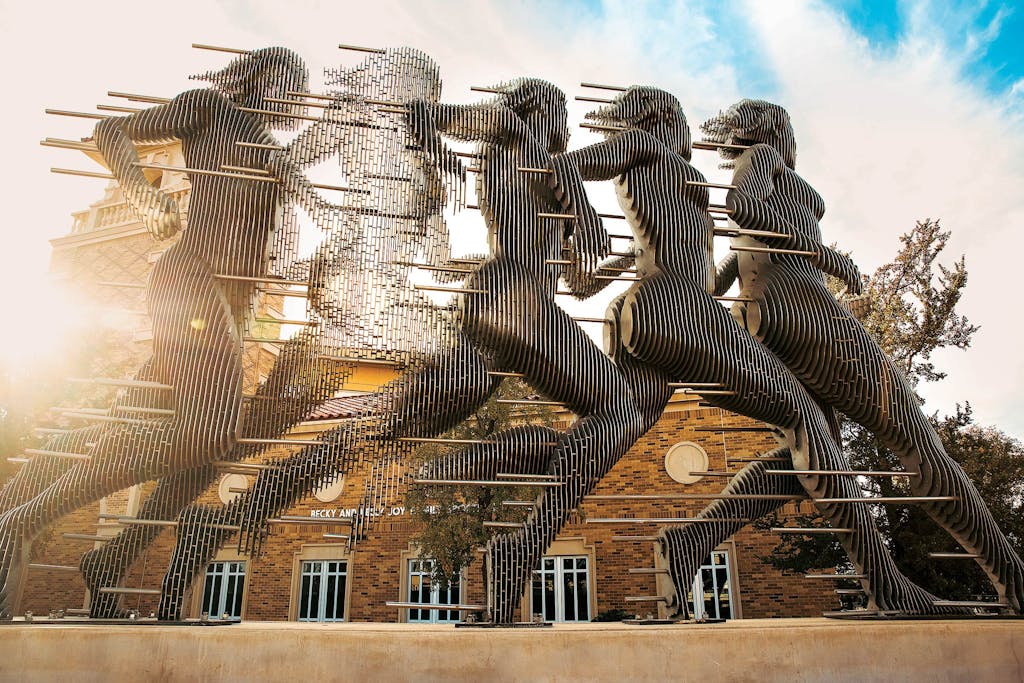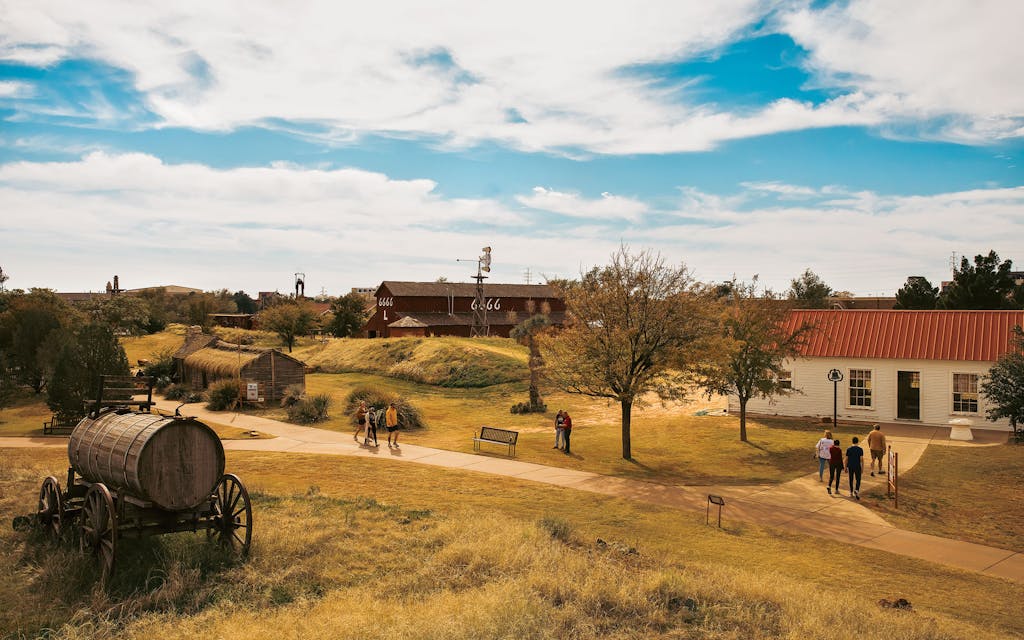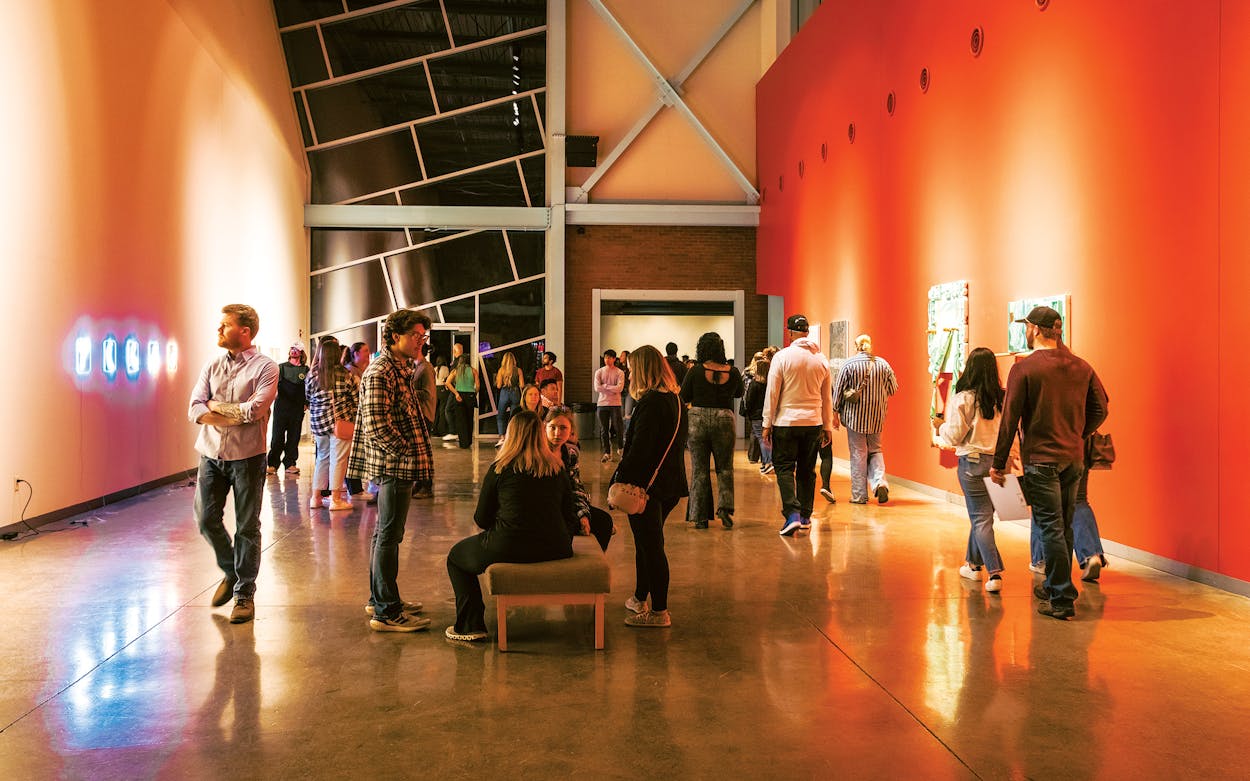On the Lubbock County Historical Commission’s Facebook page is a grainy archival image that appears to have come from a bit of nineteenth-century promotional material. It depicts a group of dapper travelers gathered on the balcony of the long-gone Nicolett Hotel, which opened in 1889. Underneath the photo are the words “A street in Lubbock, Texas, where everybody lives easy, has a good time, and makes lots of money.”
Nowadays, if you drive around the smallish grid of a downtown, with its acres of parking and comically wide avenues, you might deduce that everybody does in fact make lots of money, since it seems as if most of the buildings are banks. The remaining businesses appear to be split between good times (bars, smoke shops, tattoo parlors) and the repercussions thereof (bail bond offices, law firms, churches).
But there’s plenty more to Lubbock. Just ask the 6.4 million conventiongoers, history buffs, music lovers, Texas Tech football fans, and New Mexico–bound overnighters who make their way every year to Hub City, a moniker that likely stems from Lubbock’s long-held position as the economic, agricultural, and educational heart of the 24-county region of northwest Texas known as the South Plains.


Of the 260,000 souls who reside here, about 20 percent are college students. That’s a lot of youthful energy, and it’s likely the source of something many visitors don’t expect to find in this impossibly flat, treeless, windblown outpost on the prairie: a thriving arts culture. Lubbock’s homegrown musical luminaries attract most of the attention (see Buddy Holly, Mac Davis, Joe Ely, Natalie and Lloyd Maines, and about fifty others), but the city’s famous unbroken horizon and endless sky inspire creativity of all sorts. Visual art is everywhere, from a spectacularly weird house to an eight-ton bronze woolly mammoth, and a weekend of seeking it out is time well spent.
Downtown you’ll find benches adorned with handmade tiles, storm drains painted in hues of river blue and lake green, and walls bedecked with murals, their colors all the more vibrant for their muted setting. That artsy spirit coalesces each month at Lubbock’s rain-or-shine First Friday Art Trail. It seems as if everyone—young and old, emo kids and future farmers—shows up to downtown’s Cultural District to roam in and out of open studios, listen to live music, and sample dishes (carne guisada burritos, spaghetti with pumpkin cream sauce) from the multitude of food trucks that set up shop. Beers in hand, friends, neighbors, and visitors buy pottery and letterpress cards and ponder installations such as Kat Carmona’s Interwoven, a rainbow of puff balls suspended from the ceiling at the Louise Hopkins Underwood Center for the Arts, their fluorescent dyes activated by UV light.

Much of the art on display along the trail has been created by the students, professors, and alumni of Texas Tech University, which has long drawn those who aspire to careers in visual arts and graphic design. Providing plenty of inspiration is the school’s Public Art Collection. Scattered among and inside the main campus’s striking Spanish Renaissance–inspired buildings are about one hundred works of art, including an untitled steel sculpture by late artist (and Tech architecture teacher) Robert R. Bruno Jr. Created in 1974, the rust-colored structure reminds me of one of those all-terrain “walkers” from Star Wars. If you find it intriguing, take a thirteen-mile drive east of Lubbock to a lakeside cliff in scenic Ransom Canyon, where Bruno took that same design, added windows, and made it into a house, which you can rent on VRBO for around $500 a night. Near the English/Philosophy building stands Larry Kirkland’s Headwaters, a fountain featuring a pair of giant polished-granite hands cupping an assortment of letters. Outside the School of Art is musician and artist Terry Allen’s Liquid Assets, a bronze rebuke of corporate life in the form of a dejected-looking businessman standing inside a basin, his shoes and briefcase submerged in algae-green water.
Three years ago, the performing arts in Lubbock got their due with the construction of a world-class concert hall. It’s hard to imagine what Lubbock’s most famous artist, forever 22 years old, would have thought if you’d told him back in the fifties that his hometown would build the 220,000-square-foot Buddy Holly Hall of Performing Arts and Sciences. Designed by Diamond Schmitt Architects (whose résumé also includes Lincoln Center’s David Geffen Hall), its gradually sloping facade of angular glass and concrete fronts a lobby whose creamy white paint and polished wood put one in mind of piano keys and acoustic guitars. A white spiral staircase leading to each floor rises like a gentle tornado, and inside the auditorium, dark blue walls, curvy balconies, and hanging lights evoke the night sky, a fitting backdrop for the city’s ballet and symphony, as well as touring Broadway shows.


Art of a more practical sort can be found at the National Ranching Heritage Center. The mostly outdoor museum opened on July 4, 1976, to honor Lubbock’s early homesteaders and, presumably, educate anyone too complacent about modern-day conveniences. It’s unfortunately close to U.S. 82, but the 48 structures (moved from elsewhere in the state and restored to period accuracy) placed throughout nineteen acres of short-grass prairie are sufficient reminders of the rigors of life on the plains. On display are everything from half dugouts and dirt-floored cabins to a shedlike “hospital” for screw worm–afflicted sheep and a cow chip house, where the sun-baked disks of manure—used for fuel in a region with precious few trees—were stored. “It was the job of children in ranch families to collect the material,” states the interpretive signage. Representing the indoor-plumbing era is the Barton House. Bequeathed to the center by descendants of original owner Joseph James Barton and moved from a site 33 miles north of Lubbock, the Queen Anne–style beauty was built circa 1909 with running water and acetylene gas lighting.

If life-size sculptures of Ice Age megafauna and shockingly realistic dioramas interest you, visit the 335-acre Lubbock Lake Landmark site, operated by the Museum of Texas Tech. True-to-scale bronzes of woolly mammoths, a giant short-faced bear, and other extinct creatures embody the skeletal remains that have been found at this active archaeological preserve. Once a sheltered spring-fed lake, it dried up early in the twentieth century, likely because of drought and farming irrigation. But that allowed access to layer after layer of natural and cultural history, thirteen thousand years’ worth. Take a one-mile trail outside or head into the interpretive center and learn about carbon 14 dating, sediment deposition, and Folsom projectile points. Once enervated by the sheer volume of information, your mind will be properly blown when you round a corner and catch sight of the diorama of ancient bison butchery. Forget the majestically lit tableaux you’ve seen in other natural science museums. Amid the piped-in sound of a fierce wind, a Paleo-Indian man, his long hair aswirl, flays a very convincing dead bison, its innards exposed, as his female companion carries off a bloody haunch on her shoulder.
Don’t leave town without visiting Mackenzie Park, home to the city’s famous prairie dogs. They are master architects, though their handiwork—elaborate “apartments” that include bedrooms, nurseries, and storage rooms—is, alas, underground. But their surface-level antics are plenty entertaining. As Texas writer and sketch artist Frank Oliver put it, in 1973: “The little mammal is a born comic and ‘ham’ and where he might be seen at close range he keeps his audience squealing with delight and affection.” I could have watched the adorable critters enter and exit their grassy stage all day. Nearby, an elderly gentleman tossed roasted almonds atop their mounds, an appropriate ovation for Lubbock’s original performance artists.


Your Guide to Lubbock
Stay
Cotton Court Hotel: This Valencia Hotel Group property opened in 2020 and quickly became a community hub for Hub City. The downtown hotel was designed to evoke an industrial cotton gin, with pitched roofs, coral-colored brick, and corrugated steel cladding. The celebration of cotton continues inside, with bouquets of fluffy stems decorating the spare but stylish rooms (complete with Smeg refrigerators). Outside, the court is an open space furnished with hammocks, picnic tables, hanging fire cauldrons, and a pool. Grab a drink from Midnight Shift, the on-site restaurant, and watch the lively parade of wedding guests, sorority sisters, and luggage-cart-riding toddlers.
Eat
The Nicolett: There’s plenty of fine food in Lubbock, but the Nicolett sets the standard for culinary art. Named for the 1880s-era hotel built when Lubbock was a wee village of less than one hundred people (“Headquarters for Commercial and Ranch Men, $2 per day”), it’s housed in a 1920s-era building that was once a car repair shop and later an artist’s studio. Within earshot of passing trains, you enter through a romantic courtyard outfitted with desert plants and decorative iron gates, past a former greenhouse that serves as a private dining room, its multicolored windowpanes rescued from a disused school. The rough-hewn beauty continues inside, with a stone fireplace, terra-cotta masonry, and a slightly open kitchen, where Finn Walter, a James Beard semifinalist for best chef in Texas, melds high style with regional ingredients, as in his elk tartare and “desert gumbo” with local guinea fowl and masa harina.
Do
Buddy Holly Center: You’ll spot artistic renditions of Holly’s famous eyeglasses all over town, but seeing the real ones, recovered from the 1959 airplane crash that killed him, will stop you in your tracks. The artifacts in this pocket-size museum are exquisitely curated, a collection that illuminates a phenomenal talent and hints at what could have been.
American Windmill Museum: If there’s one thing Lubbock knows a lot about it’s wind. Be they zephyrs or haboobs, the often dusty currents of air are a constant in this far-flung burg on the Llano Estacado. So what better place to situate a museum designed to celebrate the ingenious harnessing of that awesome power? A large patch of land and a cavernous sunset-red metal building are home to the largest windmill museum in the world, displaying a collection of structures from the past two centuries, everything from an Illinois-born Little Giant to a Ding Dong from Dalwallinu, Australia. Even more unexpected and delightful is the nearly four-thousand-foot G scale train track running through a miniature world of local buildings and industries (windmills were vital to the railroads, which needed lots of water for their steam engines). Wander along the track and study the exquisitely detailed depots, lumber yards, and oil refineries. Note the tiny cattle at tiny troughs; the tiny cotton and sunflower farms, complete with tiny scarecrows; and even the tiny town of Lubbock as it looked in 1941.
Shop
Bentley Arrow: “Furniture. Revelry. Art.” That about sums it up for this wildly eclectic, decidedly weird space (and vendor of paint from interior design maven Annie Sloan). As does the word “unique,” which is often used to describe the wares at this huge two-story shop. There is probably (?) something for everyone here, if everyone is perhaps looking for a rescued carousel horse, a mirrored disco ball, a taxidermied kangaroo, or a giant “rare vintage light-up Jack in the Box head,” circa 1950, for $3,600 (it’s really something).
Jux-ta-Posh: In the Depot District, in a historic brown-brick building on Buddy Holly Avenue, you’ll find two inviting floors of furniture, ceramics, linens, baskets, bath products, and just about anything else you might need for a well-appointed home. It’s a huge space, filled with upcycled treasures including mirrored armoires, vintage wooden doors, metal file cabinets, chandeliers, and even some taxidermy. Look out an upstairs window onto the courtyard below, where an eye-catching turquoise-and-yellow mural celebrates Lubbock’s native cocktail: “When life gives you lemons, make a Chilton.”
A Beautiful Mess & Co.: This grand space deals mostly in furniture—hefty armoires, dining sets, tufted-leather sofas—but interspersed throughout are such varied finds as historical prints and vintage photos; old western books (The Fighting Tenderfoot, Wild Riding Runt); a brass-and-copper samovar, and some unintentionally hilarious amateur paintings.
Lubbock Fancy Flea & Company: A sock monkey. A camel-colored set of vintage luggage belonging to Alvin from Route 1 in Abernathy. A tooled-leather purse identical to the one my dad made in high school shop class. These are but a few of the many items in this nicely curated antiques shop in the Depot District. The aisles are packed with just the right amount of stuff, and the folks behind the counter are nice as can be.
Flatland Collection at Two Thirty Five Designs: The retail component of interior design company Two Thirty Five, this calm, spare space is high-end all the way. Intricate Turkish rugs and luxe leather furniture are the focus; rounding out the rest of the shop are select home goods (cheese plates and knives, pillow covers made of Moroccan cactus silk) and fun items like old-school plastic keychains with messages like “Low Key Psycho” and volumes from Yale University Press’s fashion series, Catwalk.
- More About:
- Lubbock









